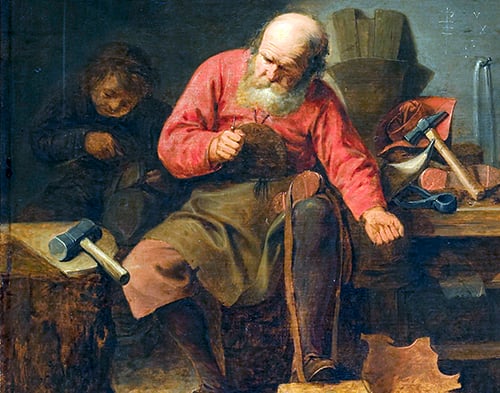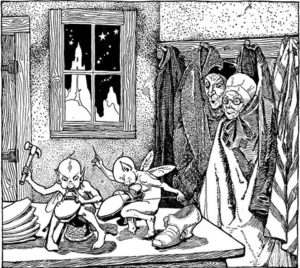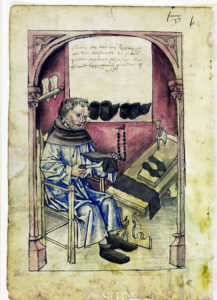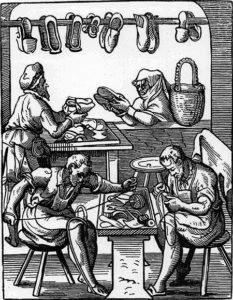
Most everyone knows the story of the shoemaker and the elves. The Grimm brothers gave us the version most of us know, and it begins this way:
There was once a shoemaker, who worked very hard and was very honest: but still he could not earn enough to live upon; and at last all he had in the world was gone, save just leather enough to make one pair of shoes.
That’s the stereotype we have: shoemakers are poor and the cobbler is even poorer. Some were. But in the Middle Ages, they also had a reputation for being lazy, as witnessed by this bit of doggerel describing the work habits of shoemakers:
Monday is Sunday’s brother
Tuesday also do they play
Wednesday they fetch the leather
Thursday they return again
Friday they cut it up
Saturday they make pants and shoes.
 So, only one day a week of actually making shoes! Poor and honest, or lazy? Happily, fiction writers can have it both ways and six other ways besides. For some ideas, it pays to look at shoemakers in history, to see how they worked.
So, only one day a week of actually making shoes! Poor and honest, or lazy? Happily, fiction writers can have it both ways and six other ways besides. For some ideas, it pays to look at shoemakers in history, to see how they worked.
Shoemakers in just about every town were organized into guilds. Since demand for shoes was inelastic, one of the chief functions of the guild was to guard against price cutting. Since prices were rather public, the main avenue for a shoemaker was to cut costs by using inferior materials, and so the guild was very much concerned with regulating quality.
The Shop
Making a shoe is not too difficult. Within any village could be found the tools, materials, and skills needed to make a serviceable work boot. The peasant could take hide from a cow, cure it himself, and cut the leather. He could take a block of wood and shape it into the form of a foot; this is called a “last”. He formed the leather around this and sewed the segments together, then nailed the result to a “bottom” (a sole). Both shoes were made the same way—making separate shoes for left foot and right foot was a specialist skill and was mainly for the rich. In some places, wood was used not only for the sole but for the entire shoe. For the rich, the uppers might be made of fine cloths, with embroidery or other work done by another specialist. In some places, shoemakers worked exclusively with the finest leathers, such as cordovan (these were known as cordwainers). Such craftsmen might sell their goods into foreign markets.
The shoemaker conforms to our stereotype of a guildsman in that his shop was usually also his home. His stock would be on shelves; these were samples, so shoppers could choose a style, which the shoemaker would then construct. His tools and workbench were in the same room. He might have a storeroom in the back holding supplies of leather, stitching, and so on. The residence would be on the second floor.
A shoemaker’s shop was measured by the number of workbenches it contained, and guilds often regulated the maximum allowed in order to keep one master from overwhelming the others. Guild regulations typically had the force of law and were backed up by the city council. The general opinion was that it was best for the community to have several or many shops operating, rather than having one drive the others out of business, so guild matters were also city matters.
Marketing
In some cases, the shoemaker didn’t have room for his shop and his residence in the same building, so he rented a stall in one of the city market squares. In the little town of Zittau, for example, there were thirty-six stalls for shoemakers and sixteen for leatherers. In Augsburg, on the other hand, the shoemaker guild was the eighth largest in the city, and this explicitly excluded cobblers.
The shoes made included riding boots, formal shoes, house shoes, work shoes and boots, children’s shoes, and even elevated shoes that raised the shoe out of the muck in bad weather. Work shoes might have triple soles. Coachmen might have special boots, and so on. Shoemakers also made leggings, which was a profitable business because leggings were subject to changes in fashion, which meant new business almost every year.
A shoemaker was both an artisan and a merchant. That is, he made shoes, but he also had to sell those shoes. Some shoemakers had wealthy clients who would come into the shop and order a pair of shoes to be custom made. But others produced shoes of generic types and sizes, putting them out in a retail stall for purchase by the general public. This second type you would find mainly in larger cities. Shoemakers were also allowed make other leather goods, such as wine sacks or belts.
Cobblers
 The poor couldn’t afford this sort of thing. They went to the cobbler, buying second-hand or shoes made from second-hand leather. Or else they went barefoot, only wrapping their feet in rags in inclement weather. Even a cobbler had to learn the trade, though, and there were apprentice and journeyman cobblers as well, especially in the countryside. It’s worth noting that the language around this trade isn’t consistent. In some places, cobbler and shoemaker were interchangeable terms, whereas in others the two were strictly separate. And just to make things more confusing, in London shoemakers were called cordwainers—originally a specialty trade but somehow the term got applied across the board in London.
The poor couldn’t afford this sort of thing. They went to the cobbler, buying second-hand or shoes made from second-hand leather. Or else they went barefoot, only wrapping their feet in rags in inclement weather. Even a cobbler had to learn the trade, though, and there were apprentice and journeyman cobblers as well, especially in the countryside. It’s worth noting that the language around this trade isn’t consistent. In some places, cobbler and shoemaker were interchangeable terms, whereas in others the two were strictly separate. And just to make things more confusing, in London shoemakers were called cordwainers—originally a specialty trade but somehow the term got applied across the board in London.
One famous shoemaker (cobbler) was Hans Sachs, a German meistersinger (like a troubador) who began life as a cobbler apprentice and then journeyman. But he was also a poet and one day he lucked into getting attached to the court of Emperor Maximilian I. No more shoemaking for Hans! He provided the text for a wonderful collection of pictures called The Book of Trades, illustrated by Jost Amman. The picture of a shoemaker’s shop shown here comes from that book.
Strike!
 Because everyone needed shoes (even though Tom Sawyer only wore shoes on Sundays), shoemakers had a certain amount of power in being organized. The famous example from the U.S. comes from 1860, which spread across much of New England. This strike involved shoemakers working in the new factories. There’s an earlier example from Germany in 1724-25, involving journeymen and guilds. By the 18th century, guilds had constricted membership so that it was almost impossible to become a master unless you were the son of a master and had married locally. This left many journeymen out in the cold, spending their entire lives as little more than hired hands.
Because everyone needed shoes (even though Tom Sawyer only wore shoes on Sundays), shoemakers had a certain amount of power in being organized. The famous example from the U.S. comes from 1860, which spread across much of New England. This strike involved shoemakers working in the new factories. There’s an earlier example from Germany in 1724-25, involving journeymen and guilds. By the 18th century, guilds had constricted membership so that it was almost impossible to become a master unless you were the son of a master and had married locally. This left many journeymen out in the cold, spending their entire lives as little more than hired hands.
What Do You Think?
Have you used a shoemaker in a story? Please share!
The standard fantasy trope is to use either the farm boy or the blacksmith’s son as the Future Hero. Would you ever use a shoemaker?
What would a magical shoemaker do? After all, someone had to make those seven league boots!
A strike or some other major conflict within a guild could make a nice backdrop for events in a story. One of your characters might be a shoemaker—journeyman or master—or maybe they just need a pair of new shoes.
Resources
J. Sparkes Hall, The Book of the Feet.
The history here is rather poor, but it has many illustrations and some great anecdotes. Read it here for free; don’t waste money buying it.
Thomas Wright, The Romance of the Shoe.
Another one you can read for free, with even more illustrations.
I. Marc Carlson, Footwear of the Middle Ages.
Very good set of essays, with an extensive bibliography. If you are interested in this topic, go here. The site includes nuggets such as a list of superstitions associated with shoes, and articles about concealed shoes.
Here’s Das Ständebuch (Book of Trades) mentioned in the article.
There are other versions around, including one with an excellent introduction by Theodore Rabb and translations of all of Sach’s verse.
E.L. Skip Knox is the creator of the fantasy world called Altearth, a place where magic is real, monsters roam the land, and the Roman Empire never fell.


I think history is a bit like science for me… when it’s not in a class it’s way more interesting. This is mainly because you get the tidbits rather than the boring, ugly details… like helping my daughter with sciene. It’s kind of interesting that heavy breathing gets oxygen to tkae care of lactid acid buildup during a burst of exercise… the details of cellular respiration are boring as crap, LOL. At least for both of us.
I had no idea a shoe maker and a cobbler were different things! I never was very fond of history lessons but this was very interesting.
I have a whole essay on the demographic crises of the 14thc–Black Death, Hundred Years War, the Great Famine. Barbara Tuchman's A Distant Mirror isn't very good history, but her sub-title hit it on the nose: it was indeed a calamitous century.
I'm not really bored with British history, but I am fed up with it. Far too many books are set there, and the peculiarities of that peculiar island get taken as the template for "medieval." So I gravitate toward other interesting areas. I've neglected Iberia, but my excuse is Italy. 😉 I know a bit about early modern Spain, thanks to J.H. Elliott, but medieval Iberia is mostly darkness illuminated by a few, rather random spotlights–crusaders at Lisbon, Charlemagne's expedition, the holdout kingdom of Asturia, the Muslim invasion of the 8thc, El Cid of course, and some equally random information about Castile and Aragon in the 15thc. Just recently I've learned about Costanza of Aragon who married first a Hungarian king and then Frederick of Hohenstaufen.
Like I said, pretty random.
I do recommend The Great Famine if you can lay hands on a copy.
Hi there Skip!
Actually no, I have not read The Great Famine by that author you have mentioned, and my knowledge of Aragonian history is quite limited. The Iberian peninsula was a huge mess before the creation of a unified Spain, and it's still a mess today in many ways. I feel that British history is more interesting, but still a lot of very important things happened in Spain.
I hope that you come up with an article about the Black Death, there are so many silly myths about that disaster in particular.
Thanks, Sheilawisz. I'm guessing you've read The Great Famine by William Chester Jordan. It's probably the best work in English. His bibliography will send you off to related works.
It's a good idea for an article; I'll put it into my idea queue. I have several articles already in development, so it'll have to get in line. 🙂
She was never a princess but she was a queen twice: have you read about Costanza of Aragon? She's 13th century.
Hello Skip!
This has been a most excellent article, thank you very much. I am always curious and very eager to learn more about what Medieval life was really like, and it so happens that shoes in particular were very interesting for me. It's something that we rarely give any importance to in our modern world, we just take shoes for granted but it has not always been like this.
As you know, I have a strong interest regarding certain 14th Century princess, and now I realize that her shoes were for sure prettier, far more expensive and a lot more durable than mine!
I do not have any shoemaker character in any of my stories.
Now that I think about it, only a few stories of mine take place in Medieval style worlds. Also, I concentrate on the story and leave world building and world details in second and third place of importance respectively. Shoemakers are part of certain classic stories as you have mentioned, so I am sure that they can be great characters in a story.
I love to learn about just how complex and well-organized the Medieval world was really like.
I have an article suggestion for you: My interest in the 14th Century in particular has caused me to read a lot about the Great European Famine of 1315, and it was quite a disaster. You could write an article about it, analyze the causes behind it like the changes in weather patterns and how the constant rain eventually affected the crops and food supply.
All of those things could be super interesting in a Medieval Fantasy story.
Barry Levinson made a pretty good movie called Avalon about growing up in Baltimore. One anecdote that has always stuck with me is how he made money as a kid by walking in men's shoes. That is, a well-to-do man who could afford to buy new shoes, would give these new shoes to the boy for a time. The boy walked around for days, breaking in the stiff leather until the man could wear the shoes without getting blisters. The boy made a dime or two.
Not about shoemakers, but at least shoe-related.
I can believe in "generational boots". Well into the 80s, I was using work boots my father had forgotten to return to the RAF in the 50s.
They were the only hard leather sole with hobnails I've ever seen or worn. They were lined inside with cardboard because you could feel the hobnails. And you still needed two pairs of wool socks. They were almost certainly war surplus from the 40s and probably the only thing I've ever worn that would have survived a nuclear attack.
That said… They only died when I stained them black and tried to get a shine on the leather. They were never destined or designed to get a good polish.
One might get an idea of durability by looking at cowboy boots, all leather and such, might be fairly comparable? No idea. I sold shoes at one point in my life, and no doubt a quality pair of cowboy boots will go through many sets of soles. I know folks who’d come in sad to be finally giving up on a pair of uppers after 20 years… yeah, they were like paper-leather, but I bet comfy, heh heh. Even a hard-working boot could survive 10 if it was a utility boot rather than supple and for looks. That wouldn’t even be using some of the heavier/thicker bull hides I’ve seen. Not sure if I’d want those on my feet, but they’d last a while, heh heh.
How long would vary wildly by occupation, weather, material, care, and chance, but this is what cobblers were for. The leather itself could last longer than a lifetime. Soles could be replaced or even just a new one put over the old one. Even stitching could be replaced. Longer than modern shoes? Mostly likely, but modern shoes generally aren't all leather. If you do take a leather shoe, though, it would still last a long time if you invested in repairs.
BTW, this is exactly the kind of question a writer wants to know and a historian doesn't. For one thing, the historical record is largely silent. When was the last time you wrote down how long your shoes lasted? It's also a question that doesn't lend itself to historical analysis, at least not for modern historians. For this sort of thing you have to go back to pre-WWII historians at the very least, or even pre-WWI. But those historians were not always critical of their sources. You might find an answer, but it might not be a very good answer, historically. For the writer, though, they're great. Lots of details and anecdotes and who cares if you can find trustworthy documentation? If it makes for a good story, I'll snatch it up.
Great article, as always. I’m curious: how long would a typical (decently made) pair of shoes last? Did they usually last longer than our mass produced shoes of today?